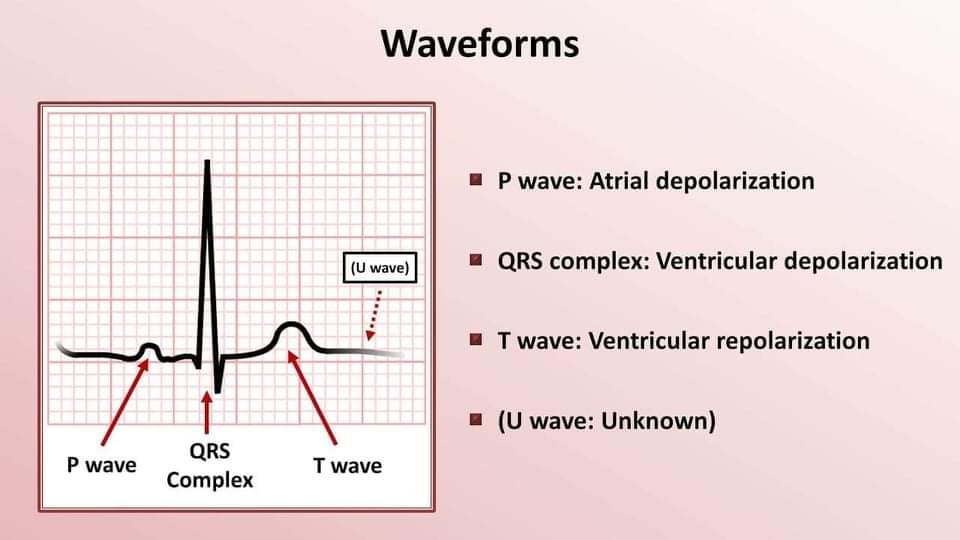ECG (Electrocardiogram) দেখলেই আমরা কেমন যেন ঘাবড়ে যাই। একটা ECG পেপার রিড করার জন্য অল্প কিছু স্টেপ ফলো করতে হয়। তাহলেই খুব সহজে মাত্র কয়েক সেকেন্ডেই ECG ইন্টারপ্রিট করা যাবে। বেসিকটুকু জানা থাকলে ECG দেখতে দেখতে একসময় পুরো ব্যাপারটা আয়ত্তে চলে আসবে।
ECG শেখার জন্য প্রচুর ECG দেখার কোন বিকল্প নেই। আর পড়তে হবে কারণ মন যা জানেনা চোখ তা দেখেনা।
একটা ECG পেপার রিড করার জন্য আমি যেটা ফলো করি সেটা বলছি।
Steps:
- Check standardization (10mv)
- Check paper speed (25mm/s)
- Check lead aVR (P and T wave inverted)
Upright P and T indicates technical fault or dextrocardia. - Check rhythm strip to count heart rate, rhythm and is there any conduction abnormality or not
- Cardiac axis (Follow rule of thumbs)
- Now watch lead V1-V6 then lead I, aVL then lead II, III, aVF
- Check ischemia and infarction

Note:
- R wave is gradually increased from lead V1 – V6
- S wave is gradually decreased from lead V1 – V6
Now look at these
ST depression- Ischemia
T inversion- Ischemia
ST elevation- Injury
Pathological ‘Q’ – Necrosis
Q is pathological when it is 2 mm deep and wide or 1/4th (25%) of R wave
Acute myocardial infarction চেনার জন্য ST segment এবং ST segment elevation চেনাটাই একমাত্র জরুরী।
ST elevation in-
Lead ll, lll, avF : AMI (Inferior)
Lead V1- V3/V4 : AMI (Anteroseptal)
Lead V5- V6 : AMI (Lateral)
Lead V1- V5/V6 : AMI (Anterior)
Lead I and aVl : AMI (High lateral)
Lead V1- V6 and lead I, aVl : AMI (Extensive Anterior)
ST elevation is significant when minimum 2mm elevated in chest lead and minimim 1mm elevated in limb lead.
And ST elevation, depression or T inversion is taken counted when at least 2 sequential leads have it. Single lead change is not significant.
- 1mm is equal to 1 small square in ECG
- Acute MI means acute ST elevated MI
Acute MI (Anterior/ Extensive Anterior):
এর সাথে Right bundle brunch block, sinus tachycardia, atrial fibrillation থাকতে পারে। Complete heart block রেয়ারলি থাকতে পারে কিন্তু সেটা তোমাদের না দেয়ারই কথা।
Acute MI (Inferior):
সাথে Sinus bradycardia, 1st degree of complete heart block থাকতে পারে।
Atrial fibrillation with fast ventricular rate:
(Heart rate >100), P wave absent or fibrilatory f wave may present, rhythm irregular.
Causes of atrial fibrillation?
- Chronic rheumatic heart disease
- Ishchemic heart disease
- Thyrotoxicosis
- Congenital Heart disease-ASD
- Hypertension
- Pulmonary infection
এছাড়া Left ventricular hypertrophy, right ventricular hypertrophy diagnosis in ECG and cause পড়তে হবে যেকোন বই থেকে।
Right bundle brunch block & left bundle bruch block দেখতে হবে।
Supra ventricular tachycardia, ventricular tachycardia এর diagnosis, cause, management অবশ্যই দেখে নিতে হবে যেকোন বই থেকে।
Supra ventricular tachycardia:
- Narrow complex tachycardia (QRS duration less than 120ms= 3mm)
- Heart rate more than 150
- Absent P wave
- R-R interval regular
Ventricular tachycardia:
- Wide complex tachycardia (QRS duration more than 120ms= 3mm)
- Heart rate more than 120/130
- Absent P wave
- R-R interval regular
Heart Block: Diagnosis, cause, management জানতে হবে।
PR interval means from the beginning of P wave to beginning of ‘Q’ wave. In absence of ‘Q’ wave it will be measured upto ‘R’ wave. This is the basic.
1st degree heart block: Prolonged P-R interval (>220ms) (more than 5.5 small square)
2nd degree heart block:
Mobitz type-1: Progressive lengthening of PR interval followed by a missed QRS complex.
তার মানে P (Atrium) কন্ট্রাকশনের রেসপন্সে প্রতি বিটে QRS (Ventricle) একটু একটু করে বেশী দেরীতে রেসপন্স করবে।একটা সময় এত দেরী হয়ে যাবে যে আরেকটি P wave চলে আসবে ভেন্ট্রিকল কন্ট্রাকশন এর আগেই মানে QRS complex এর আগেই। এর পরের কমপ্লেক্সেই আবার নতুন করে এই সাইকেল তৈরি হবে।
Mobitz type-2: Every P wave is not followed by QRS complex.
So simple it is.
P এর সব ডাকে QRS সাড়া দিচ্ছেনা।P দুইবার ডাকলে QRS একবার সাড়া দিলে 2:1 A-V block।
তিনবার ডাকলে একবার সাড়া দিলে 3:1 A-V block।
এটাই Mobitz type 2
Complete heart block: P (Atrium) and QRS (Ventricle) both are functiong well individually but there will be no coordination between ‘P’ and ‘QRS’.
That means P-P interval will be regular
QRS – QRS (R-R) interval will be regular.
As they have no coordination P-R interval will be irregular from complex to complex.
- In complete heart block P-P regular, R-R regular but P-R interval irregular in different complex.

আরেকটু সহজে বলি, Atriumএবং ventricle রেগুলার rhythm এ আলাদা রেটে চলবে।
মানে Atrium এর রেট হতে পারে 90, vemtricle এর রেট হতে পারে 35।
তার মানে প্রতিটা P এর মাঝে সমান গ্যাপ থাকবে। প্রতিটা QRS এর মাঝে সমান গ্যাপ থাকবে।
এখানে একটা কনফিউশন হতে পারে। কিছু P হারিয়ে যেতে পারে QRS complex এর ভেতরে। যার ফলে P-P regular মনে নাও হতে পারে।সেক্ষেত্রে খেয়াল রাখবে যে P-R interval ভ্যারিয়েবল কিনা এক complex থেকে আরেক complex এ এবং QRS এ হারিয়ে যাওয়া P wave কল্পনা করে নিয়ে P-P interval regular আছে কিনা খেয়াল করতে হবে। ব্যাপারটা সহজ একটু খেয়াল করলেই বোঝা যাবে, কয়েকটা ECG দেখতে হবে। তাহলেই আর ভুল হবেনা।
Conception should be crystal clear!
Heart block that means conductive system abnormality which is more common in inferior MI.
Because inferior MI happens when right coronary artery occlusion occurs.
- Now have a quick flash back to the Blood supply of Conductive system.
Sino atrial node: 60% by right coronary artery and 40% by left coronary artery.
Atrio ventricular node: 90% by right coronary artery and 10% by left coronary.
So, we can see conductive system is supplied by right coronary artery in most people. So inferior MI leads to conductive system defect or heart block (A-V block).
Acute MI, atrial fibrillation, heart block, supra ventricular tachycardia, ventricular tachycardia, left ventricular hypertrophy, right ventricular hypertrophy, left bundle brunch block, right bundle brunch block এগুলো ভালোভাবে বই থেকে একবার দেখে নিতে হবে।
আজকে এটুকুই। অনেক পড়াশোনা হয়ে গেলো একদিনে।
ধন্যবাদ সবাইকে।
ডা. মেহেদী হাসান বিপ্লব (শেবাচিম ৩৫)
কনসালটেন্ট (কার্ডিওলজি)
সদর হাসপাতাল,ভোলা
Platform Academic / Fariha Bintay Amin (Nodi)

